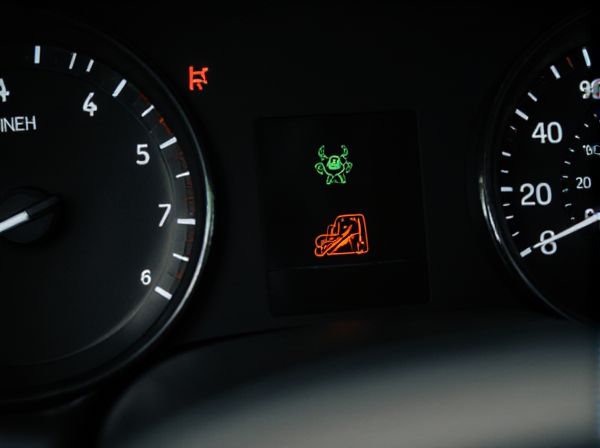
Photo illustration: Turn Signal Indicator vs Hazard Indicator
Turn signal indicators are designed to signal your intention to change lanes or make a turn, helping communicate your movements to other drivers and improving road safety. Hazard indicators, also known as emergency flashers, warn others that your vehicle is stationary or moving slowly due to an emergency or breakdown. Understanding the distinct purpose of each ensures you use them correctly to prevent accidents and maintain clear communication on the road.
Table of Comparison
| Feature | Turn Signal Indicator | Hazard Indicator |
|---|---|---|
| Purpose | Indicates vehicle turning or lane change direction | Warns other drivers of emergency or stationary vehicle |
| Activation | Engaged by lever on steering column | Activated by dedicated hazard switch/button |
| Flashing Pattern | Flashes on the side corresponding to direction (left or right) | Flashes simultaneously on both left and right signals |
| Dashboard Symbol | Green arrow pointing left or right | Red triangle symbol |
| Legal Requirement | Mandatory for indicating turns and lane changes | Mandatory during emergencies or vehicle breakdowns |
| Common Use Cases | Turning, lane changes, merging | Accidents, breakdowns, warning stopped vehicle |
Introduction to Turn Signal and Hazard Indicators
Turn signal indicators are essential automotive lights used to signal a vehicle's intended direction to other drivers, enhancing road safety by preventing collisions during lane changes and turns. Hazard indicators, also known as emergency flashers, activate all turn signal lights simultaneously to warn surrounding traffic of a stationary vehicle or an emergency situation. Both indicators play crucial roles in communicating driver intentions and ensuring safe vehicle operation on public roads.
Purpose and Functionality
Turn signal indicators primarily serve to communicate a driver's intention to change lanes or make a turn, enhancing road safety by signaling directional changes to other road users. Hazard indicators, on the other hand, activate all turn signals simultaneously to warn other drivers of a stationary vehicle, emergency situations, or potential road hazards. Functionally, turn signals operate intermittently on one side, whereas hazard indicators flash continuously on both sides.
How Turn Signal Indicators Work
Turn signal indicators function by activating a blinking light on the vehicle's front and rear, signaling the driver's intention to turn or change lanes. They operate through an electrical circuit connected to the vehicle's battery and controlled by the turn signal switch inside the car, causing the bulbs to flash at a consistent rate. Unlike hazard indicators, which activate all four turn signals simultaneously to warn other drivers of emergencies or hazards, turn signals only flash on the side corresponding to the intended direction of travel.
How Hazard Indicators Operate
Hazard indicators, also known as emergency flashers, operate by simultaneously activating all turn signal lights to alert other drivers of a vehicle emergency or temporary obstruction. These indicators use a dedicated switch that overrides the normal turn signal function, causing all four corner lamps to flash in unison at a consistent frequency. The system ensures maximum visibility and safety, especially during sudden stops, vehicle breakdowns, or hazardous road conditions.
Key Differences Between Turn and Hazard Indicators
Turn signal indicators are designed to signal a driver's intention to make a left or right turn, using blinking lights on one side of the vehicle to communicate the direction of the intended maneuver. Hazard indicators, or emergency flashers, activate all four turn signals simultaneously to warn other drivers of a stationary vehicle, collision, or other emergency situation. The key difference lies in their purpose and operation: turn signals facilitate routine lane changes or turns, whereas hazard indicators alert surrounding traffic to potential dangers or vehicle immobility.
Legal Requirements and Regulations
Turn signal indicators are legally required in most countries to communicate intended lane changes or turns, ensuring road safety and compliance with traffic laws. Hazard indicators, on the other hand, are mandated for use in emergency situations or when a vehicle is stationary in hazardous locations to alert other drivers. Regulations often specify the color, placement, and flashing frequency of these indicators to standardize visibility and effectiveness.
Common Misuses and Safety Implications
Turn signal indicators are often misused when drivers neglect to activate them during lane changes or turns, leading to confusion and increased risk of collisions. Hazard indicators are mistakenly used while driving to signal slow-moving vehicles, which can mislead other drivers about the vehicle's intentions and cause rear-end accidents. Understanding the correct use of turn signals for directional changes and hazard lights for emergencies is crucial to maintaining road safety and preventing traffic incidents.
Dashboard Symbols and Their Meanings
Turn signal indicators on the dashboard are typically green arrows pointing left or right, signaling a vehicle's intended direction change to other drivers. Hazard indicator symbols, often represented by a red or orange triangle, activate all turn signals simultaneously to warn of an emergency or obstruction. Understanding these dashboard symbols ensures proper communication and safety on the road.
Maintenance and Troubleshooting Tips
Turn signal indicators require regular inspection of bulbs, fuses, and wiring for proper flashing and alignment to avoid signaling failures. Hazard indicators demand checking the hazard relay and switch functionality frequently to ensure simultaneous activation of all signal lights during emergencies. Clean contacts and secure connections in both systems help prevent intermittent operation and enhance overall vehicle safety.
Importance of Using Indicators Correctly
Proper use of turn signal indicators is crucial for communicating intended lane changes or turns, enhancing road safety by preventing accidents and misunderstandings among drivers. Hazard indicators should be activated during emergencies or when a vehicle is stationary on the roadside, alerting other road users to potential dangers and reducing collision risks. Misuse or neglect of these signals increases the likelihood of traffic incidents and impedes efficient traffic flow.
 caratoz.com
caratoz.com